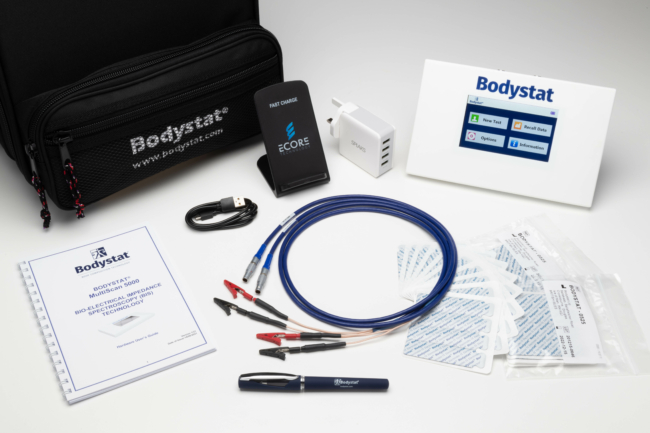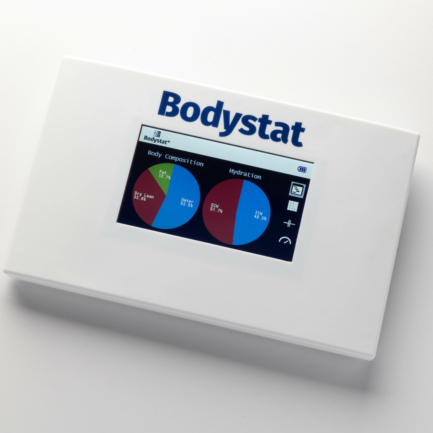Knowledge Base
What Is Body Composition Analysis?
Body composition analysis provides a detailed breakdown of an individual's weight regarding muscle, fat and water. It offers a more accurate description of body weight than traditional Body Mass Index (BMI) and can accurately depict changes in fat mass, muscle mass and total body fat percentage. This analysis is vital for athletes, medical patients and anyone pursuing health and wellness.
Why is Body Composition Analysis Better than BMI?
Body Mass Index, or BMI, is a widely recognised method to evaluate an individual's health by comparing their weight to their height. However, despite its frequent use in healthcare settings, BMI is not an accurate measure for tracking weight changes. This is mainly because it does not distinguish whether weight variations are due to changes in fat or muscle mass.
For example:
A 5’10 adult who weighs 210 lbs (15 stone) would have a BMI of 30.1 which is in the obese BMI category.
However, without more information on body composition, it is impossible to truly determine the overall health of the individual. For example, this person may be a weightlifter, meaning they have a lot of muscle mass adding to their weight but not in an unhealthy way as with excess fat.
Relying solely on a single metric like BMI to forecast health or mortality oversimplifies health risks and overlooks several crucial factors that play a significant role in maintaining good health.
How is Body Composition Analysis Performed?
Several methods are employed to perform body composition analysis, providing detailed insights into the proportion of fat, muscle and bone in the body. One of the most accurate methods is the DXA/DEXA Scan that employs x-ray technology to assess muscle and fat mass and bone density.
Similarly, devices capable of bioelectrical impedance spectroscopy are used to measure fat, water and lean tissue. Skinfold measurements, taken with callipers, provide a painless way to get body fat readings. Hydrostatic weighing, another method, calculates body composition using water displacement.
These various methods give a thorough understanding of one's body composition, aiding in setting health and fitness goals.
What Data Does Body Composition Analysis Provide?
Critically, body composition analysis provides a percentage of body fat (PBF), which represents the proportion of your total weight that is pure fat. This includes both essential fat, necessary for normal physiological function and excess fat.
In addition, it provides data on lean body mass, encompassing everything in your body not categorised as fat; this includes muscles, bones, organs and body water. Some methods of body composition analysis can further break down lean mass into its constituent components, such as skeletal muscle mass and bone mineral content.
The analysis also provides information on body water, divided into intracellular water (inside cells) and extracellular water (outside cells). This crucial balance is important for health and performance.
Another significant metric is basal metabolic rate (BMR), the number of calories your body needs to perform essential functions at rest. This data can be useful in devising a nutrition plan.
What Can Body Composition Data be Used For?
Understanding the applications of body composition data can greatly aid in various health and fitness contexts. It provides a detailed picture of an individual's physical health and weight loss, beyond what a regular scale can offer. This data can indicate whether one is losing body fat, gaining muscle, or both and can be a predictor of one's physical fitness level and risk for chronic diseases.
In a medical context, body composition data can be essential for patient monitoring and treatment. For example, it is used to measure fluid overload in litres for dialysis, cachexia, sarcopenia and lymphoedema patients. This helps in ensuring the patient's safety and in improving the quality of care.
Body composition data can also play an important role in the world of sports and fitness. It helps athletes maintain an ideal shape and mass for peak performance. Athletes can use this data to make precise adjustments to their diets and training regimes.
Moreover, body composition analysis is gaining traction in the pharmaceutical industry. It is increasingly being used in drug prescription to better identify the minimum effective dose, thereby reducing the risk of side effects and improving treatment outcomes.
What are the Benefits of Body Composition Analysis?
Body composition analysis offers numerous benefits, particularly in providing essential insights into one's health and fitness progress. It goes beyond the limitations of BMI, offering a detailed breakdown of your body concerning fat, muscle and bone. This is important in understanding not just your weight, but where that weight comes from.
One notable benefit of body composition analysis is its ability to track changes in fat mass and lean mass over time. This is especially beneficial for individuals engaged in fitness or weight loss programs. Monitoring these metrics can help determine if a program is effective in reducing fat and building muscle.
Body composition analysis also plays a significant role in identifying health risks. Higher percentages of body fat, especially visceral fat, can increase the risk of conditions like heart disease and diabetes. By knowing your body composition, you can take proactive measures to manage these risks.
In addition, understanding your body composition can aid in setting realistic fitness goals and planning targeted nutrition and exercise strategies. Regular analysis allows fine-tuning of these plans, leading to more effective and sustainable results.
What is a Body Composition Analyser?
Body composition analysers are specialised devices dedicated to measuring the various parameters key to determining body composition. They offer a more detailed and all-encompassing view of one's health by helping professionals determine fat percentage, muscle mass, skeletal muscle mass and hydration levels.
Examples of Body Composition Analysers
Devices like the Bodystat Multiscan 5000, which use multi-frequency bioelectrical impedance analysis provide detailed body composition data. This particular device is fully portable and can offer professionals from various industries an all-in-one tool to measure body composition with great accuracy.
Below are just some of the insights that the Multiscan 5000 can offer:
- Fat percentage
- Lean body mass
- Dry Lean Weight
- Skeletal Muscle Mass (SMM)
- Body Cell Mass
- Total Body Water % and in litres plus normal ranges
- ECW and ICW levels
- Volume of Overhydration
- Basal Metabolic Rates
- BMR/Body Weight
- Average Daily Calorie Requirement
- Body Mass Index (BMI)
- BFMI (Body Fat Mass Index)
- FFMI (Fat Free Mass Index
- Waist/Hip Ratio
- Cell Membrane Capacitance
Promoting Health & Performance with Body Composition Analysis
Understanding an individual's body composition provides essential insights into physical fitness levels and potential disease risks. Regular monitoring and strategic adjustments in diet and exercise can improve body composition. Nevertheless, achieving ideal body composition requires a commitment to time, dedication and patience. Hence, body composition analysis serves as an invaluable tool in setting realistic fitness goals and promoting overall health.
Related Articles
Discover more expert guides
Speak to the experts
Got a question?





